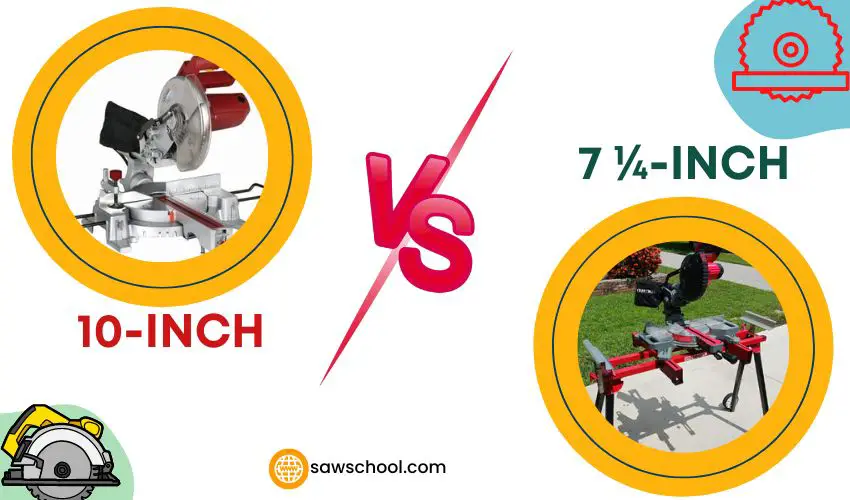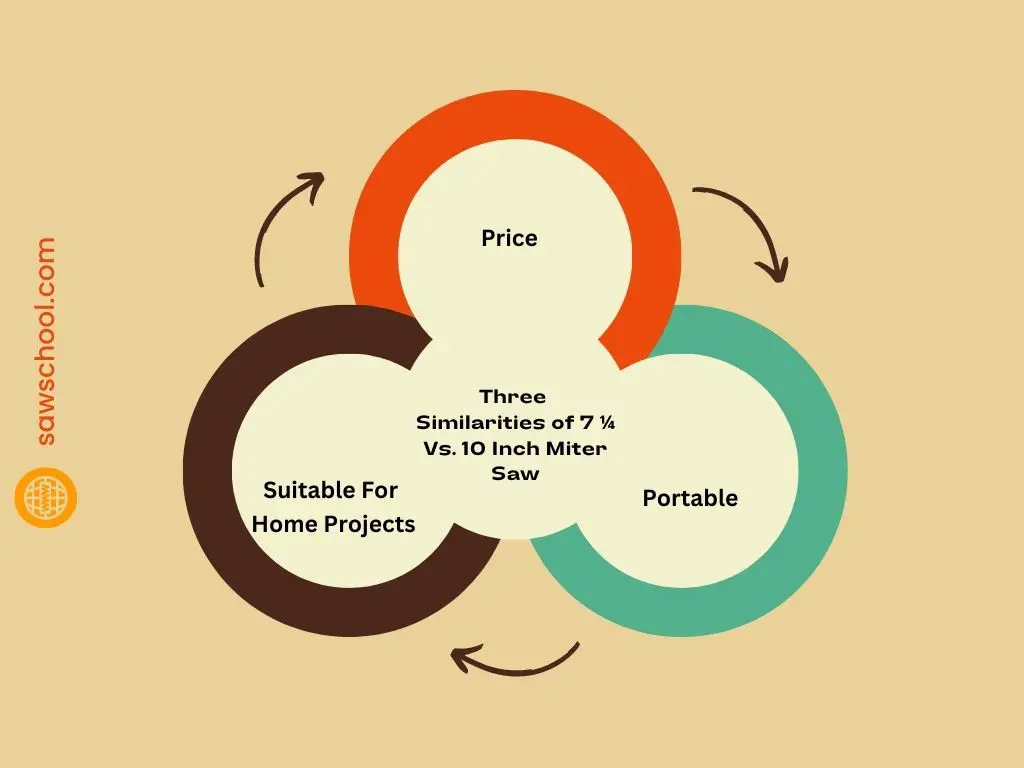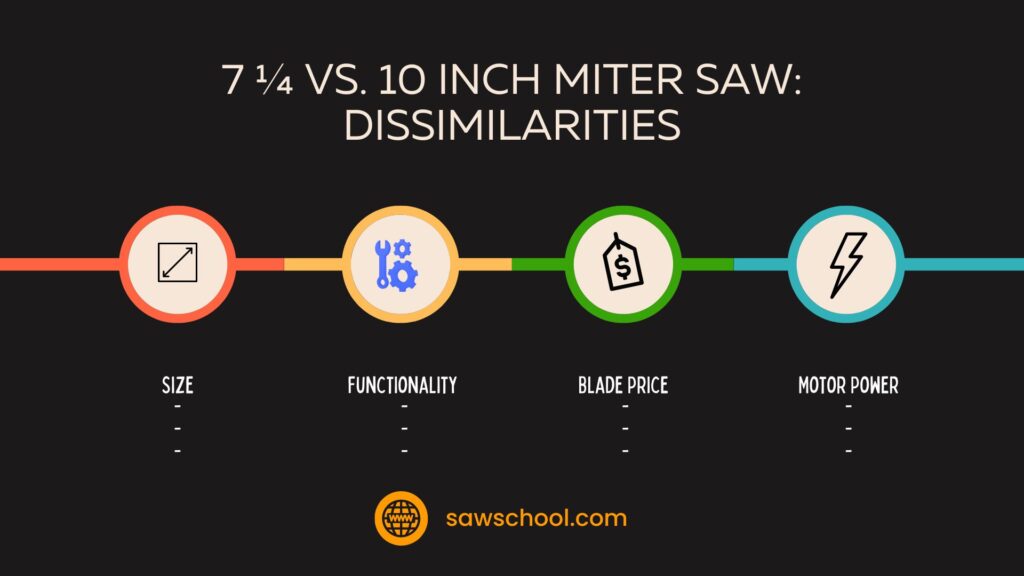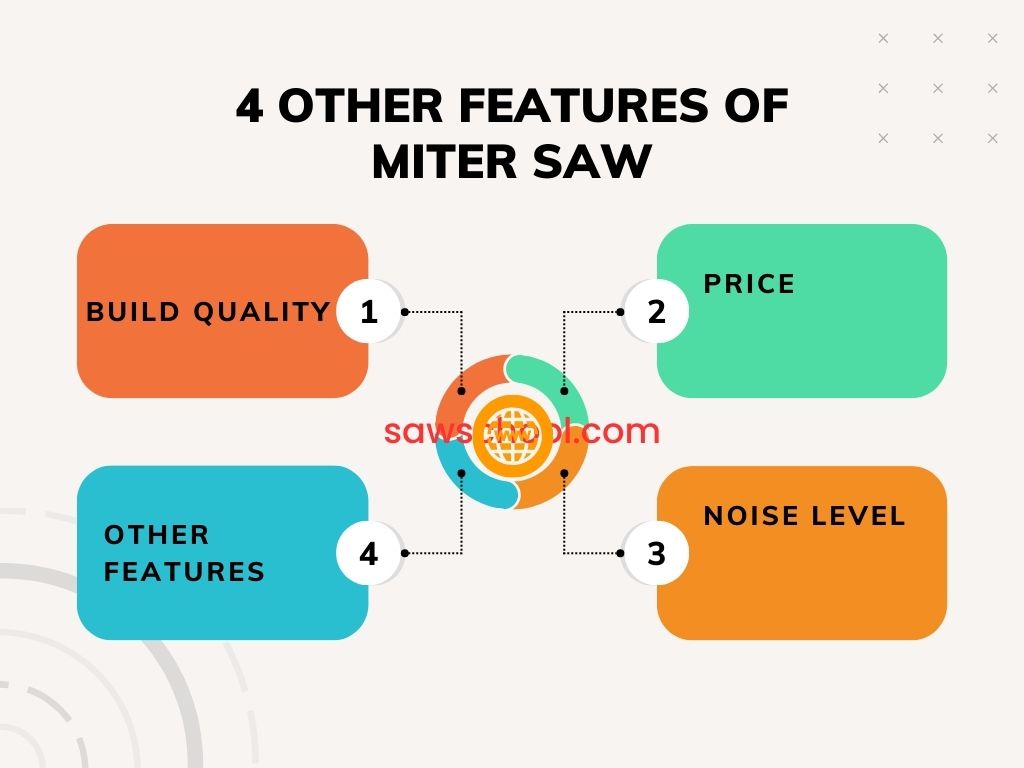Investing in a miter saw can be an intimidating decision to make, especially if you are a newbie. There are so many options that seem similar to one another that it’s surprising not to get confused between them. Two such examples are a 7 ¼ vs. 10 inch miter saw.
There are some significant similarities and dissimilarities between a 7 ¼ inch miter saw and a 10 inch miter saw. Both of them are affordable options and suitable for any home project. However, they differ in size, functionality, and other aspects.
If you want to get a detailed comparison between the two options, make sure to read the entire article.

7 ¼ Vs. 10 Inch Miter Saw: 3 Common Similarities
Some features of a 7 ¼ inch miter saw and a 10 inch miter saw are so similar that many people assume that they can use the units interchangeably. Even though that’s not the case, the similarities are significant. Let’s take a look at them.

Price
Both miter saws are extremely affordable. When comparing different-sized miter saws, both saws are usually kept under the same category. That’s because you can get either of them by spending a reasonable amount of money.
There’s no reason to think that there aren’t expensive options when it comes to these small-sized miter saws. You will be surprised to see the highest prices for these miter saws. Nonetheless, the good news is that you won’t have to pay that much to get a decent miter saw.
Portable
Most of the time, both 7 ¼ inch miter saws and 10 inch miter saws are conveniently portable. Sometimes, a 10 inch miter saw might not be as portable as a 7 ¼ inch miter saw. Still, both of them can be considered portable.
So, whether you have a shortage of garage space or want to take your miter saw to a job site, both options will be excellent for you.
Suitable For Home Projects
10 inch and smaller miter saws are usually considered DIY units. That means professionals generally don’t singularly use them for their work. However, they may keep either of them as a supporting unit to increase the diversity of their workshop. For instance, when there’s a lot going on in a professional’s workshop, they can assign one of these miter saws for a particular task to speed up production.
With that being said, if you are searching for a unit that will work as your personal assistant for DIY projects, both of them are excellent options.
7 ¼ Vs. 10 Inch Miter Saw: 4 Common Dissimilarities
As similar as these two miter saws are, the differences between them can’t be ignored either. It’s crucial to understand the meticulous differences between ¼ inch miter saw and a 10 inch miter saw if you do not want to put your money in the wrong place. So, let’s see what differentiates one from the other.

Size
The title of this article makes it obvious that the two miter saws are different in size. But what does it mean when it says a 7 ¼ inch miter saw and a 10 inch miter saw? The size actually refers to the blade size that the miter saws use.
A 7 ¼ inch miter saw uses a 7 ¼ inch blade, whereas a 10 inch miter saw uses a 10 inch blade. There are perks and downsides to the blade size, but let’s not get ahead of ourselves.
Functionality
Even though the functionality is not that different in both miter saws, it’s worth mentioning. There are some limitations of a 7 ¼ inch miter saw due to its small size. For instance, you can go for 1 x 12 or 2 x 12 pieces of materials using this miter saw. However, you cannot cut a 4 x 4 piece with this miter saw.
On the other hand, the 10 inch miter saw provides a wider range of cutting diameters due to the blade size. You can cut a 4 x 4 size material using a 10 inch miter saw. So, if this is an important factor for you, the wise choice would be to pick a 10 inch miter saw.
Another factor to discuss under functionality is beveled cuts. Most 7 ¼ inch miter saws won’t offer you beveled cuts while most 10 inch miter saws will. So, make sure you consider that before investing.
Blade Price
This goes in favor 7 ¼ inch miter saw. Because of the small size, the blades for a 7 ¼ inch miter saw come extremely cheap compared to others. Even when you’re getting a high-end blade, you will have to pay a significantly lower amount compared to a 10 inch miter saw.
Because the blade is something you may have to change frequently, a 7 ¼ inch miter saw can be proved to be a more affordable unit in the long run. Besides, you can also get more diversity by investing in a variety of blade types.
Motor Power
Generally, a 10 inch miter saw will provide you with slightly better performance as well as motor power. However, this is not always the case. You can find plenty of options where 7 ¼ inch miter saw will offer better motor power than a 10 inch miter saw. Nonetheless, the price difference might be significant in this situation.
The same can be said for the range of speed you get with these miter saws. A 10 inch miter saw will have a slight advantage over the 7 ¼ inch miter saw if you are looking at units in the same price range.
7 ¼ Vs. 10 Inch Miter Saw: The Verdict
The verdict is clear. A 10 inch miter saw is comparatively more diverse than a 7 ¼ inch miter saw. That doesn’t necessarily mean that it’s a better solution for you. Because both options are suitable for home projects, you can pick any of them that suits your needs more specifically.
For instance, let’s say the most important feature for you is portability. A 7 ¼ inch miter saw will certainly be more lightweight than a 10 inch miter saw even though they are both portable options. The blade variety you get to keep because of the low prices also favors the 7 ¼ inch miter saw.
On the contrary, if you need to cut 4 x 4 pieces and you want your miter saw to be able to make beveled cuts, you should go for a 10 inch miter saw. If you are still unsure of the differences between these options, check out this article from 99 power tools.
Other 4 Features To Look For
The size of the miter saw isn’t the only thing to determine whether it’s the best available option suitable to you. Let’s take a look at some crucial aspects that you should consider before getting a new miter saw.

Build Quality
You should always look for the most basic qualities first. For instance, the build quality of a miter saw is one of the core qualities. The better the build quality, the more durable your miter saw will be.
Price
Setting your budget is extremely important before buying anything. First, budget how much you will be spending and then list the features you want your miter saw to have. Then, match the qualities with the budget. You will soon come up with a short list of miter saws.
Noise Level
Even though it’s not a mandatory feature to look for, many users signify this attribute over other qualities. So, if the sound of a miter saw bothers you, quietness is something you should be looking for. You can check my article on most quiet miter saw if you are interested.
Other Features
A miter saw is a unique combination of a variety of features. What you prioritize depends on your preference. Some may prefer to look at what warranty policy they’re getting, while others may think about the included components.
Frequently Asked Questions

Why buy a 7 ¼ miter saw?
There are several reasons to consider a 7 ¼ inch miter saw. The most attractive features of a miter saw this size is its portability, lightweight structure, affordability, and ability to cut materials into various sizes.
Can a 7 ¼ miter saw cut a 4×4?
Generally, a 7 ¼ inch miter saw cannot cut a 4 x 4, not in one cut anyway. If this is an important feature for you, it’s better to consider a 10 inch miter saw instead of a smaller one.
Final Words
Hopefully, this detailed comparison of 7 ¼ vs. 10 inch miter saw has answered all your questions. Many users will suggest you invest in a 10 inch miter saw because it’s more diverse with its cuts.
Nonetheless, every individual has different needs when it comes to a miter saw. And you don’t need to look for any extra features in the unit you are investing in that you won’t utilize when using the miter saw.
